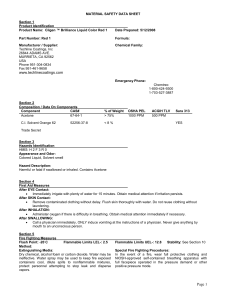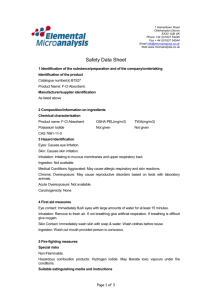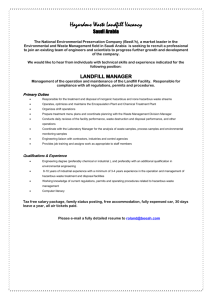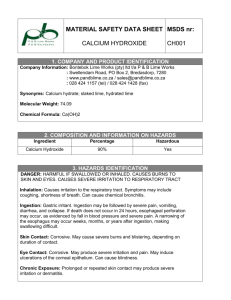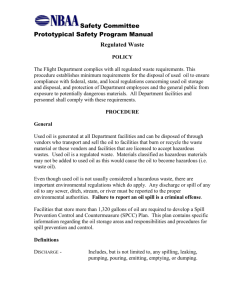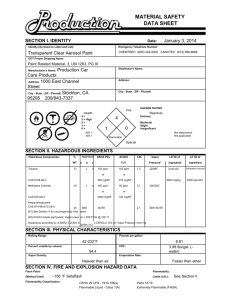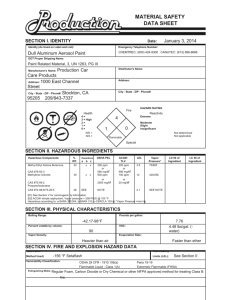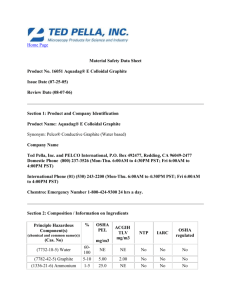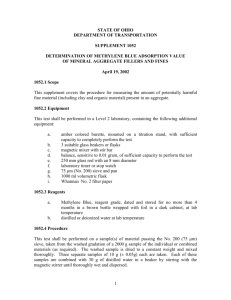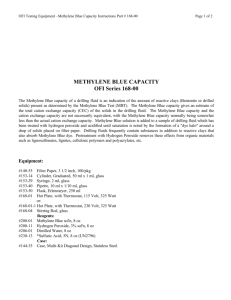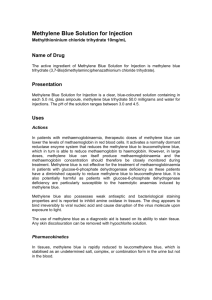section 1: product and company identification
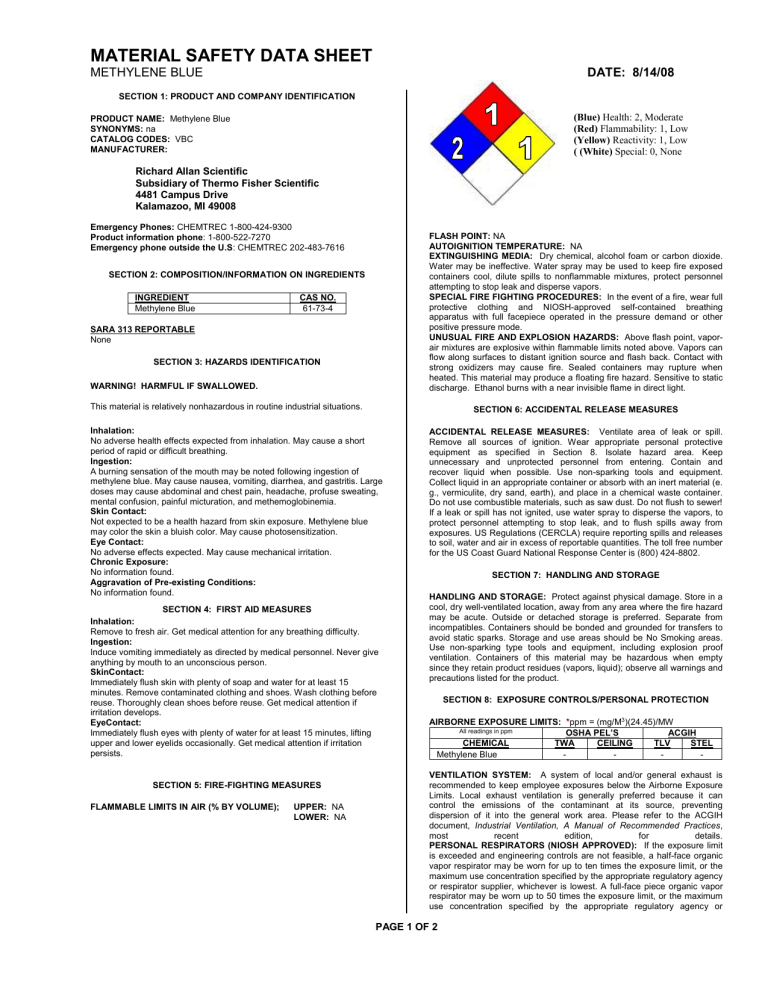
MATERIAL SAFETY DATA SHEET
METHYLENE BLUE
DATE: 8/14/08
SECTION 1: PRODUCT AND COMPANY IDENTIFICATION
PRODUCT NAME: Methylene Blue
SYNONYMS: na
CATALOG CODES: VBC
MANUFACTURER:
Richard Allan Scientific
Subsidiary of Thermo Fisher Scientific
4481 Campus Drive
Kalamazoo, MI 49008
Emergency Phones: CHEMTREC 1-800-424-9300
Product information phone : 1-800-522-7270
Emergency phone outside the U.S
: CHEMTREC 202-483-7616
SECTION 2: COMPOSITION/INFORMATION ON INGREDIENTS
INGREDIENT
Methylene Blue
SARA 313 REPORTABLE
None
CAS NO.
61-73-4
SECTION 3: HAZARDS IDENTIFICATION
WARNING! HARMFUL IF SWALLOWED.
This material is relatively nonhazardous in routine industrial situations.
Inhalation:
No adverse health effects expected from inhalation. May cause a short period of rapid or difficult breathing.
Ingestion:
A burning sensation of the mouth may be noted following ingestion of methylene blue. May cause nausea, vomiting, diarrhea, and gastritis. Large doses may cause abdominal and chest pain, headache, profuse sweating, mental confusion, painful micturation, and methemoglobinemia.
Skin Contact:
Not expected to be a health hazard from skin exposure. Methylene blue may color the skin a bluish color. May cause photosensitization.
Eye Contact:
No adverse effects expected. May cause mechanical irritation.
Chronic Exposure:
No information found.
Aggravation of Pre-existing Conditions:
No information found.
SECTION 4: FIRST AID MEASURES
Inhalation:
Remove to fresh air. Get medical attention for any breathing difficulty.
Ingestion:
Induce vomiting immediately as directed by medical personnel. Never give anything by mouth to an unconscious person.
SkinContact:
Immediately flush skin with plenty of soap and water for at least 15 minutes. Remove contaminated clothing and shoes. Wash clothing before reuse. Thoroughly clean shoes before reuse. Get medical attention if irritation develops.
EyeContact:
Immediately flush eyes with plenty of water for at least 15 minutes, lifting upper and lower eyelids occasionally. Get medical attention if irritation persists.
SECTION 5: FIRE-FIGHTING MEASURES
FLAMMABLE LIMITS IN AIR (% BY VOLUME); UPPER: NA
LOWER: NA
PAGE 1 OF 2
(Blue) Health: 2, Moderate
(Red) Flammability: 1, Low
(Yellow) Reactivity: 1, Low
( (White) Special: 0, None
FLASH POINT: NA
AUTOIGNITION TEMPERATURE: NA
EXTINGUISHING MEDIA: Dry chemical, alcohol foam or carbon dioxide.
Water may be ineffective. Water spray may be used to keep fire exposed containers cool, dilute spills to nonflammable mixtures, protect personnel attempting to stop leak and disperse vapors.
SPECIAL FIRE FIGHTING PROCEDURES: In the event of a fire, wear full protective clothing and NIOSH-approved self-contained breathing apparatus with full facepiece operated in the pressure demand or other positive pressure mode.
UNUSUAL FIRE AND EXPLOSION HAZARDS: Above flash point, vaporair mixtures are explosive within flammable limits noted above. Vapors can flow along surfaces to distant ignition source and flash back. Contact with strong oxidizers may cause fire. Sealed containers may rupture when heated. This material may produce a floating fire hazard. Sensitive to static discharge. Ethanol burns with a near invisible flame in direct light.
SECTION 6: ACCIDENTAL RELEASE MEASURES
ACCIDENTAL RELEASE MEASURES: Ventilate area of leak or spill.
Remove all sources of ignition. Wear appropriate personal protective equipment as specified in Section 8. Isolate hazard area. Keep unnecessary and unprotected personnel from entering. Contain and recover liquid when possible. Use non-sparking tools and equipment.
Collect liquid in an appropriate container or absorb with an inert material (e. g., vermiculite, dry sand, earth), and place in a chemical waste container.
Do not use combustible materials, such as saw dust. Do not flush to sewer!
If a leak or spill has not ignited, use water spray to disperse the vapors, to protect personnel attempting to stop leak, and to flush spills away from exposures. US Regulations (CERCLA) require reporting spills and releases to soil, water and air in excess of reportable quantities. The toll free number for the US Coast Guard National Response Center is (800) 424-8802.
SECTION 7: HANDLING AND STORAGE
HANDLING AND STORAGE: Protect against physical damage. Store in a cool, dry well-ventilated location, away from any area where the fire hazard may be acute. Outside or detached storage is preferred. Separate from incompatibles. Containers should be bonded and grounded for transfers to avoid static sparks. Storage and use areas should be No Smoking areas.
Use non-sparking type tools and equipment, including explosion proof ventilation. Containers of this material may be hazardous when empty since they retain product residues (vapors, liquid); observe all warnings and precautions listed for the product.
SECTION 8: EXPOSURE CONTROLS/PERSONAL PROTECTION
AIRBORNE EXPOSURE LIMITS: * ppm = (mg/M
3
)(24.45)/MW
All readings in ppm OSHA PEL’S ACGIH
CHEMICAL TWA CEILING TLV STEL
Methylene Blue - - - -
VENTILATION SYSTEM: A system of local and/or general exhaust is recommended to keep employee exposures below the Airborne Exposure
Limits. Local exhaust ventilation is generally preferred because it can control the emissions of the contaminant at its source, preventing dispersion of it into the general work area. Please refer to the ACGIH document, Industrial Ventilation, A Manual of Recommended Practices , most recent edition, for details.
PERSONAL RESPIRATORS (NIOSH APPROVED): If the exposure limit is exceeded and engineering controls are not feasible, a half-face organic vapor respirator may be worn for up to ten times the exposure limit, or the maximum use concentration specified by the appropriate regulatory agency or respirator supplier, whichever is lowest. A full-face piece organic vapor respirator may be worn up to 50 times the exposure limit, or the maximum use concentration specified by the appropriate regulatory agency or
MATERIAL SAFETY DATA SHEET
METHYLENE BLUE
respirator supplier, whichever is lowest. For emergencies or instances where the exposure levels are not known, use a full-face piece positivepressure, air-supplied respirator. WARNING: Air-purifying respirators do not protect workers in oxygen-deficient atmospheres.
SKIN PROTECTION: Wear impervious protective clothing, including boots, gloves, lab coat, apron or coveralls, as appropriate, to prevent skin contact.
EYE PROTECTION: Use chemical safety goggles and/or a full face shield where splashing is possible. Maintain eye wash fountain and quick-drench facilities in work area.
US DOT
Not
Regulated
IMO
Not
Regulated
IATA
DATE: 8/14/08
SECTION 14: TRANSPORT INFORMATION
Not
Regulated
RID/ADR
Not
Regulated
SECTION 15: REGULATORY INFORMATION
CANADIAN
TDG
Not
Regulated
SECTION 9: PHYSICAL AND CHEMICAL PROPERTIES
Appearance: Dark Blue.
Odor: Odorless.
Solubility: Soluble in water.
Specific Gravity: Not Available. pH: Not Available
% Volatiles by volume @ 21C (70F): 0
Boiling Point: Decomposes.
Melting Point: 100 - 110C (212 - 230F)
Vapor Density (Air=1): 13
Vapor Pressure (mm Hg): Not Available
Evaporation Rate (BuAc=1): No Available
Decomposition: 164 deg C
SECTION 10: STABILITY AND REACTIVITY
STABLE UNSTABLE
Yes
Stability:
Stable under ordinary conditions of use and storage.
Hazardous Decomposition Products:
May produce oxides of nitrogen, sulfur and carbon when heated to decomposition.
Hazardous Polymerization:
Will not occur.
Incompatibilities:
Strong oxidizing agents, alkali, dichromates, alkali iodides, reducing agents.
Conditions to Avoid:
Heat, flame, ignition sources, dusting and incompatibles.
SECTION 11: TOXICOLOGICAL INFORMATION
TOXICOLOGICAL INFORMATION:
1180 mg/kg LD50 oral rat. Investigated as a mutagen, reproductive effector.
TSCA
CERCLA/SARA
Clean Air Act
Clean Water Act
OSHA
State
International Regulations
CAS #61-73-4 is listed on TSCA inventory.
None of the chemicals in this material have an RQ.
This material does not contain any hazardous air pollutants. This material does not contain any
Class 1 Ozone depletors. This material does not contain any
Class 2 Ozone depletors.
None of the chemicals in this product are listed as Hazardous
Substances under the CWA.
None of the chemicals in this product are listed as Priority
Pollutants under the CWA. None of the chemicals in this product are listed as Toxic Pollutants under the CWA.
None of the chemicals in this product are considered highly hazardous by OSHA
None
CAS #61-73-4 is listed on
Canada’s ingredient list.
DISCLAIMER: The information is provided without any representation or warranty, express or implied, regarding the accuracy or correctness. The conditions or methods of handling, storage, use, and disposal of the product are beyond our control and may be beyond our knowledge. For this and other reasons, we do not assume responsibility and expressly disclaim liability for loss, damage or expense arising out of or in any way connected with the handling, storage, use or disposal of the product.
SECTION 12: ECOLOGICAL INFORMATION
Environmental Fate:
When released into the soil, this material is not expected to evaporate significantly. When released into water, this material is not expected to evaporate significantly. This material has an estimated bioconcentration factor (BCF) of less than 100. This material is not expected to significantly bioaccumulate. When released into the air, this material is expected to be readily degraded by reaction with photochemically produced hydroxyl radicals. When released into the air, this material may be removed from the atmosphere to a moderate extent by wet deposition. When released into the air, this material may be removed from the atmosphere to a moderate extent by dry deposition.
Environmental Toxicity:
No information found..
SECTION 13: DISPOSAL CONSIDERATIONS
WASTE DISPOSAL METHOD: Whatever cannot be saved for recovery or recycling should be handled as hazardous waste and sent to a RCRA approved incinerator or disposed in a RCRA approved waste facility.
Processing, use or contamination of this product may change the waste management options. State and local disposal regulations may differ from federal disposal regulations. Dispose of container and unused contents in accordance with federal, state and local requirements.
